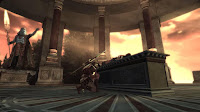Rise of the Argonauts is a game that
gets very little notice today. When I bought it, I didn't know anything about it beyond the store page description. Yet several of my friends, on seeing some of my screenshots show up their activity feeds, commented, "I LOVED that game!" With some not aware there was a PC port. It's understandable, I guess; Codemasters is more famous for their Formula 1 games than for dialog-driven RPGs based on Greek mythology. Still, there is a lot of fun to be had with Rise of the Argonauts if a dialogue-driven hack 'n slash piques your interest (as it did mine). The use of Greek legend provides a great ambiance, and unique ways to upgrade and play give it some replay value, too. An easy game to recommend if you are looking for a change of pace.
Gameplay
+ Combat flows well. Plenty of weapons and armors to acquire and choose from. They all differ visually and provide unique bonuses.
+ Plenty of slow-motion finishing moves.
+ Skill trees are organized around a different Greek god, and your combat develops in the manner your favored god prefers. Ares, Apollo, Hermes and Athena each have their own styles, buffs and debuffs.
+ "God powers." I took most of Hermes' upgrades; calling forth lightning and great winds was very cool.
+ Bosses can be quite hard (though since much of the game is easy, this might be seen as an unexpected difficulty spike).
+ Three of the key locations - Saria, Kythra, and Mycenae - can be visited in any order.
+ Conversation choices sometimes result in different outcomes.
+ Some conversation choices are timed, some are not. Watch carefully.
+ Some unique uses of the dialog options - like the forum debate on Kythra.
+/- Non-boss enemies are easy, even the minotaurs (get the Hermes "strike from behind" damage bonus and they'll fall in three hits).
+/- Long levels, but they're generally narrow corridor affairs. If you arrive at some open ground, that telegraphs horde or boss level combat is about to happen.
+/- Manually saving the game does not save your immediate location; it saves your last checkpoint.
+/- Lots of dialogue. I like BioWare games like Mass Effect and Dragon Age, so I wasn't bothered by it. But there were times that my sword-arm began to itch from inaction.
- Only four "god powers" accessible at a time. Clearly an effect of being ported from a console. Would have been better to bind them to the number keys, allowing the use of up to 10. Though that might have made the game TOO easy.
- Not much enemy variety. Your standard mobs and mini bosses in a variety of numbers and spawns.
- No co-op. With Jason being accompanied by two other Argonauts on most missions, seems like there was an opportunity to implement co-operative play, but it is an opportunity missed.
Characters
+ Rise of the Argonauts is clearly inspired by some sword-and-sandals epic movies from the early '00s. If Gladiator or Troy (or even some classics like Spartacus or The Robe) are something you like, you'll find yourself enjoying this one. I found myself rooting for Jason, sympathizing with Lycomedes, disgusted by Achilles (though still admiring his prowess), admiring Atalanta's power and resourcefulness, sorry for Medusa... The characters are generally well done and a great draw. Hercules is let down badly by his voice actor.
Narrative
+ You play as Jason of Iolcus, king of ancient myth, whose wife Alceme is murdered by nefarious assassins. Instead of accepting her death, he sets out upon a journey across Greece in search of the one artifact that is reputedly able to reverse death: the Golden Fleece. Visit the Oracle at Delphi, and find descendants of Hermes, Athena, and Ares in Saria, Kythra, and Mycenae. Then venture into Tartarus and, upon returning, defend Iolcus. That's the story in a nutshell.
- The enemy force, the "blacktongues," are your standard dark-magic mobs.
Graphics etc.
+ Graphics are fairly decent (Unreal 3). Showing their age, but still colorful and vibrant (if low-res at times).
+ SUPERB soundtrack. Composer Tyler Bates channels the feel of Troy and Gladiator and perfectly sets the mood. In some cases, the music saves the game from other, less-excellent elements.
+ Light on system resources. Rise of the Argonauts uses Unreal 3, and it is well-optimized here.
+ Cheap. $9.99 in the store? and even cheaper during sales? That's a good value, considering the amount of content.
+/- Characters (women AND men) are all idealized representations of the human form. Translation: the women are sexy, and the men have bulging muscles and ripped abs. This didn't bother me, but if you're hoping for something more "politically and socially correct," well, you won't find that here.
- Mouth movement not always synced to the dialog.
- The voice-acting is bland, whether due to the level of writing or the actual effort of the actors is hard to tell. A few stand out - like Pan and Lycomedes - and Brian Bloom as protagonist Jason does his best, but overall the effect is forgettable. Disappointing because dialogue plays such a large part in the game.
































